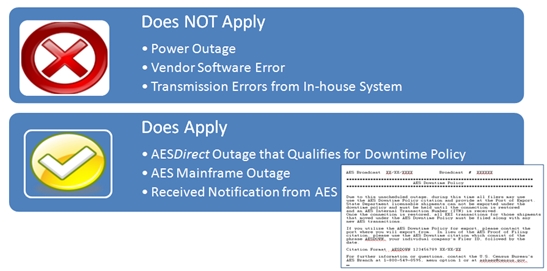A look into the AES Downtime Policy
A look into the AES Downtime Policy
The Inside Scoop
As it is with all technology, there is always a possibility for system interruption. Although we have dedicated people working continuously behind the scenes maintaining the system, what can I say? Even the Titanic was built to be “unsinkable”. In case the Automated Export System (AES) or AESDirect is inoperable, the U.S Census Bureau and Customs and Border Protection (CBP) agreed to a contingency plan, the AES Downtime Policy, which allows businesses to continue their daily activities without compromising the security of our nation’s borders and the integrity of valuable export statistics.
The AES Downtime Policy guidelines provide uniform procedures for the processing of Electronic Export Information (EEI) when the AES is unavailable for transmission.
What the Guidelines Say
“All possible precautions have been taken to minimize downtime of the AES. However, occasionally downtime may be experienced due to routine and/or unscheduled maintenance of AES performed by the CBP, Office of Information Technology. Also, downtime can be caused by damage to the National mainframe computer by natural disaster, war, civil disturbance, or catastrophic breakdown…”
When this is the case, the AES Downtime Citation may be used on the loading documents in lieu of an AES Internal Transaction Number (ITN). This consists of the phrase AESDOWN, your individual company’s Filer ID, followed by the date.
AESDowntime Citation: AESDOWN – Filer ID – Date of Export (MM/DD/YYYY)
When To Use…When NOT To Use
Yes, like I said, this policy should only be used when the AES Mainframe or the AESDirect program is unavailable for transmission for a specified period of time and the Downtime Policy has been officially enacted. Now, say you’re trying to file a shipment and you do not receive a response within 30 minutes? Do you use the Downtime Citation? NO. This also means that if you are having problems connecting to the Internet, if your company lost power, or if you are receiving transmissions errors, you may NOT use the AES Downtime Policy.
In the event of an AES or an AESDirect outage that qualifies for the Downtime Policy, a nationwide broadcast message will be issued by the U.S. Census Bureau to the entire trade community, including all ports of export. AESDirect users will see a notification upon login as well.
Under no circumstances should controlled shipments, whether regulated by the State Department or other export licensing agency, leave the country without a valid ITN.
Stay away from convenient misconceptions
Use this chart to determine when you may use the AES Downtime Policy

Be proactive about the future
Since we cannot anticipate when an unscheduled AES Outage might occur, we encourage your company to have a contingency plan in place. So in the case an outage does occur,we strongly recommend the following so there is minimal impact on your daily business transactions.
Know a Freight Forwarder! It is a good idea to build a relationship with a Freight Forwarder if your system goes down. They can file EEI on your behalf in a time-pressing situation.
Have an AESDirect Account! If you do not use AESDirect as method of filing EEI, it is a good idea to create an account in the case of a disruption to your company’s transmissions to the AES.Why not? It’s free to have one!
Keep a log! Once the AES is restored, all the EEI transactions for shipments that moved under the AES Downtime Policy must be filed to the AES. It is easier to file for these shipments if you keep a log of the shipments that need to be filed.



